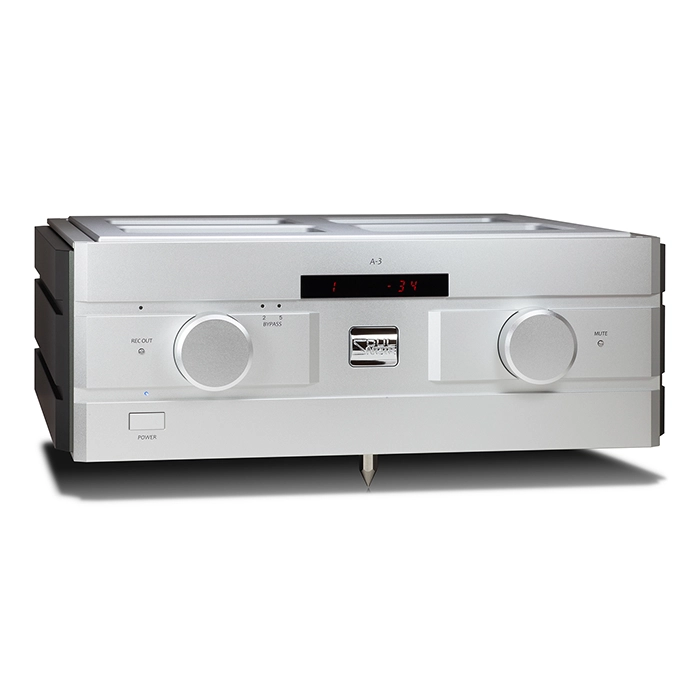Soulnote A-3 Integrated Amplifier
The A-3 is Soulnote’s flagship integrated amplifier.
With Series 3 the build quality and fit/finish takes a step up over Series 2, the A-3 is 184mm tall (this includes the spiked feet) and weighs in at 31kg. As well as being larger, the design of Series 3 is marginally different to Series 2, the construction is superior as is the level of isolation in the way the chassis and sockets are all floated to maximise performance.
The A-3 delivers 120 watts into 4ohms (they do not provide a power rating at 8ohms) there is more than enough power and current delivery to drive almost any speaker you can think of, with ease.
There are 3 pair of both RCA and XLR inputs as well out a record output, there are rear switches should you wish to fix the level of one input (to integrate into a surround system for example)
To improve performance the top cover, bottom cover, the amplifier block and all terminals (including power) all are loose/unfixed and are designed to float.
Sonically the A-3 takes the performance of the A-2 and builds on it in every way imaginable. The sound from the A-3 is at both vivid and refined, dynamic and relaxed, it is an exquisite sounding amplifier with performance right out of the very top drawer.
From Soulnote:
Complete separation of left and right channel GNDs
The GND separation technology incorporated in the P-3 pre-amplifier is applied to this model with a power amplification circuit. Originally, how to ground the GND of a power amplifier that handles high current to the chassis was a key design issue, and there is no precedent for GND non-grounding. However, ungrounding of the power amplifier’s enclosure was achieved through simple non-NFB circuits, optimized artwork design, minimization of high current loops, elimination of inductance components, and other factors. This led to the birth of the integrated amplifier A-3 with completely separated left and right GND. Furthermore, by separating the control signals of the selector, volume, protection circuit, and other relays with a photocoupler, we could achieve complete GND separation, taking capacitance and inductive components into consideration. The three-dimensional sound field space and spaciousness are the new frontiers of integrated amplifiers.
4-stage Darlington configuration with super-powerful driver and pre-driver
To drive the TO3(Metal CAN-type) transistor easily, ultra-powerful TO3P transistors are used in the driver as well as in the pre-driver. Ensuring perfect current supply all the way to the bottom end without regard to hfe fluctuation at high currents makes it possible to achieve both deep expressiveness and an exciting groove.
Single push-pull output stage
The output stage uses a single push-pull SEPP circuit with a TO3(Metal CAN-type) bipolar transistor as used in the M-3. It realizes blur-free music reproduction with correct timing from ultra-low to super-high frequencies. The heart-stirring music reproduction is the result of the single push-pull that does not break the micro time axis accuracy.
Copper bus bar heat sink
A lightweight, compact copper plate is used as the main heat sink. This heat sink also serves as a bus bar for supplying power to the TO3(Metal CAN-type) transistor, and the terminals of the TO3(Metal CAN-type) transistor penetrate the bus bar and are mounted directly on the board underneath. This eliminates wiring, which is a drawback of the TO3(Metal CAN-type) transistor, and helps overcome instability caused by the inductance component, while at the same time avoiding sound quality degradation caused by the insulation sheet dumping on the device. The sound quality effect is also extremely impressive, with a sense of freedom and transparency due to the physical independence of the heat sink from the chassis. Furthermore, in the A-3, the power supply board and amplifier board are connected by a bus bar heat sink, which also serves as a structural component to form a block. It is truly a “four birds with one stone” heat sink.
New Type-R circuit, fully balanced non-NFB
For voltage amplification, a newly developed high-gain-to-GND single-stage Type-R circuit is adopted. Naked foil resistors are used generously for all resistors involved in amplifier operation.
GND switching selector
The selector that disconnects to GND was an important point of the P-3. This is also employed in the A-3. It eliminates sound quality degradation caused by GND loops that occur when many playback devices are connected. The highest grade RSR custom relay is applied for the relay.
Resistor-switching volume
The resistor-switching volume is the simplest and allows for the least freshness deprived from the sound source. Of course, RSR custom relays and naked foil resistors are used throughout. This is the highest-grade volume ever considered.
GND anchor
The GND of the left and right channel power supply units is grounded to the left and right-side metal insulated with ceramic washers, a special enclosure construction that acts as a GND anchor. A sense of openness and low-end grip is achieved at a high level.
Super-strong power transformer
2x 700VA unimpregnated toroidal power transformers are used for the power amplification, to the left and right. In addition, three power transformers, including the control system power transformer, are packed into one enclosure. They are all mounted vertically so that the magnetic field lines are parallel to the board.
High-speed non-NFB power supply
For the rectifying capacitor, a specially selected high withstand voltage small capacitance low magnification foil filter capacitor of only 470uF is used. To optimize the capacity, the number of units used was determined and the load on the power transformer was reduced. This further improved the real regulation of the ultra-powerful power transformer. For the rectifier diodes, SiC diodes of the latest specifications with enhanced allowable inrush current are used. This is the most powerful and high-speed power supply configuration ever considered. In addition, two large power relays with excellent sound quality are used independently and without fixing as power switches for the two main power transformer. In other words, the power switch on the front panel is dedicated to the control system sub-transformer. Independent power switch for each power transformer, which is a high current contact point, is extremely crucial for sound quality.
Unfixed structure
The amplifier block, terminals, AC inlet, top cover, and bottom cover are all unfixed. In particular, the amplifier block uses a three-point lateral sliding structure with titanium sliders. While escaping from the harmful vibration of the power transformer, it also releases its own intrinsic vibration.
Volume bypass function
One each of XLR and RCA can be set for volume bypass with gain fixed at 22dB. By connecting the output of an AV preamplifier, it can be used as an AV power amplifier.
Multiple-unit connection function
By connecting a 3.5Φ stereo mini-plug cable, multiple units can be linked (simultaneous control of volume, etc.). By setting a leader and a follower, all followers will follow the state of the leader. In addition, the follower can differentiate between the leader’s and the follower’s volume. This function enables, for example, volume control in a multi-amp configuration with digital channel dividers after DA conversion. Of course, the floating GND of the control system eliminates problems such as GND loops caused by coupling.
REC OUT function
REC IN / REC OUT terminals are provided to connect an open reel deck or digital recorder.A connection can be made with XLR or RCA cables.











